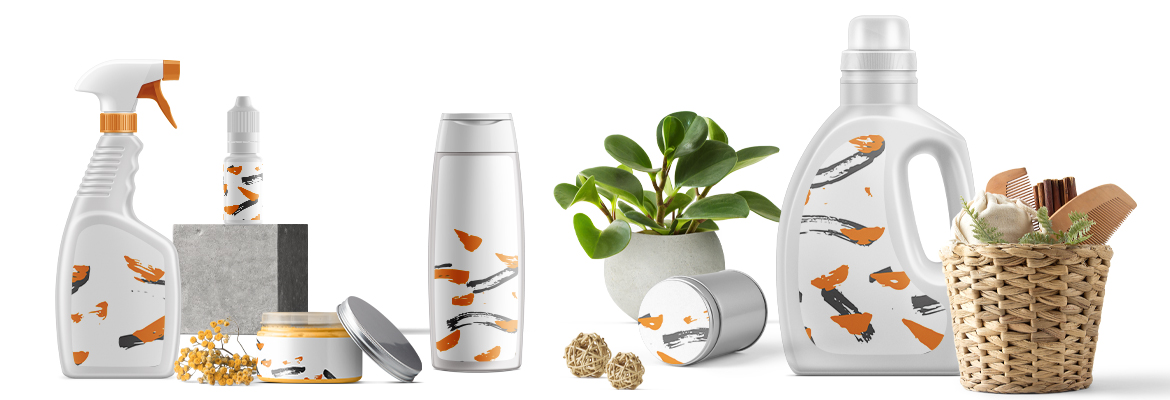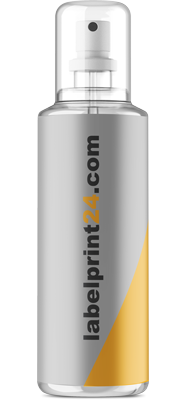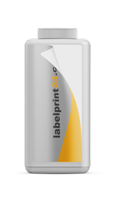Film labels

You can use your specifications to calculate plastic film labels pricing online at Labelprint24 in any format you wish, in many materials, and whatever design you come up with. We carry a wide range of printed and unprinted plastic film labels on rolls or as multi-layered labels (booklet labels, multi-layer labels). The unprinted surfaces on all of our film labels can in principle be printed using thermal transfer methods.
- Select the film and the type of adhesive below on this page.
- Your choices will then be automatically added to the corresponding price calculator.
Note:
- Upon request, we are also glad to do test runs on your materials or other special materials.
1. Film labels - an overview of the materials
Labels made from plastic film are much more suitable for outdoor use and for use in proximity to situations prone to heavy soiling or chemical exposure than labels made of paper (without additional lamination). In principle, almost all plastic foils that are suitable for label printing are dirt and water repellent and smudge-resistant, but they do have different levels of resistance to environmental influences (dirt, grease, oil, chemicals, rain, sunlight, ageing, seawater, UV stability, etc.).
1.1 PE labels
Made from robust polyethylene film, PE labels are suitable for both indoor and outdoor applications as they are weather-resistant and withstand heat and cold. The polyethylene film is stretchable and is therefore particularly suitable for flexible and deformable containers (squeezy bottles, tubes, pots, canisters). On the other hand, polyethylene is only minimally resistant to UV radiation and should therefore not be exposed to direct sunlight for a prolonged period. To achieve optimum results in subsequent printing of PP labels by thermal transfer, we recommend using our resin or mixed ribbons.


Material: Polyethylene film + adhesive
Application: indoor and outdoor use, dry and wet areas
Thickness: approx. 80µm
Temperature: -4 °F to +176 °F
For use on: especially suited for squeezable containers, squeeze bottles, tubes, jar,...
Sample applications: labels for cosmetics, decorative labels, product labels,...
Additional feature: subsequently thermal transfer printable, thermal transfer ribbons in online shop
Thickness: approx. 80µm
Temperature: -4 °F to +176 °F
For use on: especially suitable for flexible, deformable containers with a rough surface
Sample applications: industrial labelling, squeezable bottles, tube labels,...
Note: adhesive with very high initial adhesion for extra-permanent bonding
Additional feature: subsequently thermal transfer printable, thermal transfer ribbons in online shop
Thickness: approx. 80µm
Temperature: -4 °F to +176 °F
For use on: especially suited for squeezable containers, squeeze bottles, tubes, jar,...
Sample applications: industrial labels, labels for medicines, labels for cosmetics,...
Note: very elegant appearance combined with hot foil stamping
Additional feature: subsequently thermal transfer printable, thermal transfer ribbons in online shop
1.2 PP labels
Made from robust polypropylene film, PP labels are suitable for both indoor and outdoor applications; they are weather resistant and withstand high and low temperatures. Polypropylene material have a particularly high strength and are ideal for labelling rigid and round containers (drums, canisters, containers, glass bottles, hard plastic packaging).


Material: Polypropylene film + adhesive
Thickness: approx. 50-60µm
Temperature: -4 °F to +176 °F
For use on: particularly suitable for rigid containers and round containers
Sample applications: cosmetics labels, industrial labels, chemical labels,...
Additional feature: subsequently thermal transfer printable, thermal transfer ribbons in online shop
Thickness: approx. 50-60µm
Temperature: -22 °F to +176 °F
For use on: particularly suitable for rigid containers and round containers
Sample applications: raffle tickets, promotional labels, removable labels,...
Additional feature: subsequently thermal transfer printable, thermal transfer ribbons in online shop
Thickness: approx. 50-60µm
Temperature: -40 °F to +176 °F
For use on: rigid containers - such as glass, PET, food packaging,...
Sample applications: food labels, pharmaceutical labels, packaging labels,...
Additional feature: subsequently thermal transfer printable, thermal transfer ribbons in online shop
Thickness: approx. 50-60µm
Temperature: -4 °F to +176 °F
For use on: rigid containers - such as glass, PET, jars, cosmetics packaging,...
Sample applications: labels for cosmetics, laboratory labels, pharmaceutical labels,...
Note: add matte coating to get a especially natural look and feel for your labels
Additional feature: subsequently thermal transfer printable, thermal transfer ribbons in online shop
Thickness: approx. 50-60µm
Temperature: -22 °F to +176 °F
For use on: rigid containers - such as glass, PET, plastics, cartons...
Sample applications: raffle labels, removable labels, brand labels...
Additional feature: subsequently thermal transfer printable, thermal transfer ribbons in online shop
Thickness: approx. 50-60µm
Temperature: -4 °F to +176 °F
For use on: rigid containers - such as glass, PET, plastics, cartons...
Sample applications: labels for spirits, cosmetics labels, food labels,...
Additional feature: subsequently thermal transfer printable, thermal transfer ribbons in online shop
1.3 PVC labels
Labels made from polyvinyl film withstand all environmental influences better than PE and PP labels. The material can withstand extreme cold and heat and resists dirt, oils, fats, and also chemicals (alkalis, solvents, acids, oils, brake fluids). The film is UV-stable and resistant against seawater and is therefore suitable for outdoor applications in any environment. Polyvinyl chloride material is stretchable within limits and very tear resistant.
Material: Polyvinyl film + adhesive
Thickness: approx. 90µm
Temperature: -4 °F to +176 °F
For use on: ideal for deformable + rigid containers alike
Sample applications: auto labels, brand labels, warning labels, decorative labels,...
Additional feature: subsequently thermal transfer printable, thermal transfer ribbons in online shop
1.4 Help with material selection
Some factors to consider when selecting materials and adhesives:
- Storage (exposure to the elements, temperature, UV resistance, moisture, heat, cold, dirt, dust, contact with chemicals)
- Transport (seawater, scratch-resistant, ageing)
- Containers (surface tension, ductility)
- Further processing (thermal load, printing technology)
- Migration rules (food labels)
The material and characteristics of the product packaging are just as important as the label material. Packaging made from low-energy plastics (such as PE and PP) or rough surfaces on other materials, extra strong adhesives with high initial adhesion should be selected. The deformability of the product packaging that comes into contact with the label is critical for your choice of material.
Rough guide to choosing the right film for your labels:- PE film - with deformable containers not exposed to higher thermic loads
- less expensive, toxicologically harmless, even suitable for greasy food products
- PP film - with solid containers which are not deformable and also must withstand higher temperatures
- more tear-resistant than PE and PVC material
- PVC film - when stored outdoors and for goods with extensive transport routes by sea and/or longer time in transit
- UV stable, durable, resists seawater
- adheres even to uneven surfaces
- not suitable for food without barrier layer due to migration of plasticizers








 Roll labels request form
Roll labels request form  Booklet labels request form
Booklet labels request form  Folding boxes request form
Folding boxes request form  Custom made shipping boxes request form
Custom made shipping boxes request form  Package leaflets request form
Package leaflets request form  Laminate tubes request form
Laminate tubes request form 



















